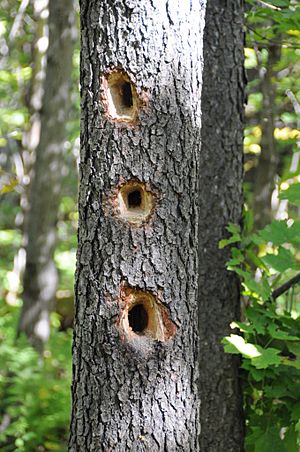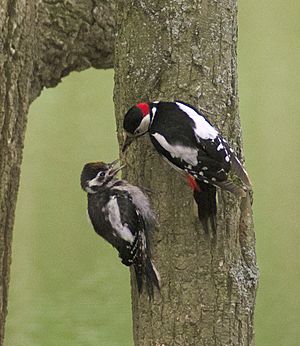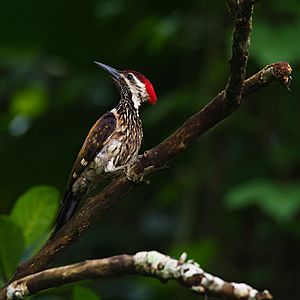Woodpecker facts for kids
Quick facts for kids Woodpecker |
|
|---|---|
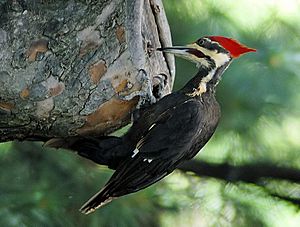 |
|
| Pileated woodpecker |
|
| Scientific classification |
|
| Kingdom: | Animalia |
| Phylum: | Chordata |
| Class: | Aves |
| Order: | Piciformes |
| Infraorder: | Picides |
| Family: | Picidae Leach, 1820 |
| Subfamilies | |
|
|
Woodpeckers are a special type of bird that belongs to the family called Picidae. This family also includes birds like piculets, wrynecks, and sapsuckers.
These birds are famous for how they act. They mostly look for insects to eat on tree trunks and branches. They also talk to each other by drumming with their beaks on trees. This drumming makes a loud sound that can travel far. Some woodpeckers also eat fruits, other birds' eggs, small animals, tree sap, food scraps from humans, and even dead animals.
Woodpeckers usually make their homes and sleep in holes they dig in tree trunks. These old holes are very important for other birds that can't dig their own nests. Sometimes, woodpeckers can cause problems for people by making holes in buildings or eating fruit crops. But they are also very helpful because they eat insect pests that harm trees.
Contents
What Makes Woodpeckers Special?
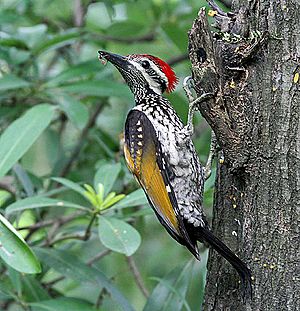
How Big Are Woodpeckers?
Woodpeckers come in many sizes. The smallest ones are tiny piculets. The smallest piculet is the bar-breasted piculet, which is only about 7.5 cm (3 in) long and weighs about 8.9 g (0.3 oz).
Some of the biggest woodpeckers can be more than 50 cm (20 in) long. The largest living species is the great slaty woodpecker. It weighs about 430 g (15 oz) and can be up to 563 g (20 oz). It measures between 45 to 55 cm (18 to 22 in). However, two extinct woodpeckers, the imperial woodpecker (55 to 61 cm or 22 to 24 in) and the ivory-billed woodpecker (around 48 to 53 cm or 19 to 21 in and 516 g or 18 oz), were likely even bigger.
Feathers and Colors
The feathers of woodpeckers can be plain or very colorful. Many species have colors like olive and brown, or they might be black and white. These colors help them blend in with their surroundings. Other woodpeckers have bright patterns of black, white, and red. Many also have a crest or fluffy feathers on top of their heads.
Woodpeckers change all their feathers once a year. The only exception is the wrynecks, which change some feathers again before they lay eggs.
Strong Feet and Tails
Woodpeckers, piculets, and wrynecks have feet that are great for holding onto tree branches and trunks. They can walk straight up tree trunks! Besides their strong claws and feet, woodpeckers have short, powerful legs. This is common for birds that often look for food on tree trunks.
All woodpeckers, except piculets and wrynecks, have stiff tails. When a woodpecker is on a tree trunk, its tail and feet work together to keep it steady.
Amazing Beaks
Woodpeckers have very strong beaks that they use for drilling holes and drumming on trees. Their beaks are usually longer, sharper, and stronger than those of piculets and wrynecks. The tip of their beak is shaped like a chisel. They keep it sharp by pecking.
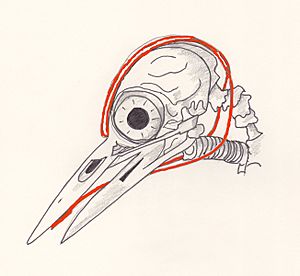
To protect their brains from all the fast, strong pecking, woodpeckers have special body parts. These features help keep their brains safe from harm.
Where Woodpeckers Live
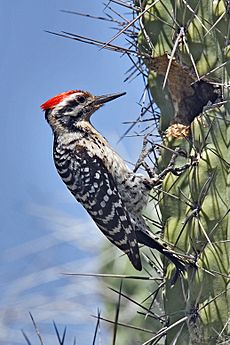
Woodpeckers Around the World
You can find woodpeckers almost everywhere in the world! However, they are not found in Australia, Madagascar, or Antarctica. They are also missing from some islands in the ocean.
Most woodpeckers stay in one place their whole lives. But a few species do migrate, meaning they travel long distances. The woodpeckers that migrate do so during the day.
Where Woodpeckers Make Their Homes
Woodpeckers generally live in woodland areas. They are most common in tropical rainforests, but they can live in many different places. These include forests, savannahs (grassy plains with scattered trees), scrublands, and bamboo forests. Some species have even moved into grasslands and deserts.
Some woodpeckers can live in areas where forests have been cut down. They can adapt to new forests growing back, tree farms, orchards, and parks. Usually, woodpeckers that live in forests need rotting or dead wood to find food.
A few species spend some of their time looking for food on the ground. A very small number of woodpeckers don't use trees at all and make their nests in holes in the ground. The ground woodpecker is one example, living in the rocky, grassy hills of South Africa. The Andean flicker is another.
How Woodpeckers Behave
Most woodpeckers live alone. Some are very aggressive towards other woodpeckers, while others live in groups. When they are aggressive, they might point or jab their beaks, shake their heads, flick their wings, chase others, drum, or make loud calls.
Woodpeckers that live in groups often raise their young together. Most birds sleep alone and will chase away other birds from their sleeping spot. But the Magellanic woodpecker and acorn woodpecker share their sleeping places.
Drumming: Their Special Language
Drumming is a way most woodpeckers communicate without using their voices. They hit their beak very fast on a hard surface. After a short break, they repeat the drumming. Each type of woodpecker has its own special drumming pattern. This pattern includes how many beats are in the roll, how long the roll lasts, how long the break is, and the rhythm.
Drumming is mostly used to mark their territory, like how a songbird sings. Woodpeckers pick surfaces that make a loud sound, like a hollow tree. They might even use human-made things like gutters. Drumming also helps woodpeckers recognize each other and is part of their courtship (mating) rituals.
Woodpecker Calls
Woodpeckers make many different sounds. These include short, high-pitched notes, trills, rattles, twittering, whistling, chattering, nasal churrs, screams, and wails. Both male and female woodpeckers use these calls to communicate. The type of call depends on the situation, such as courtship, fighting over territory, or alarm calls. Each species has its own set of calls. Mated pairs might make quiet, low-pitched calls to each other. Young birds in the nest often make loud begging calls.
What Woodpeckers Eat
Most woodpeckers eat insects and other small creatures that live under bark and in wood. But overall, woodpeckers can eat many different things. Their diet includes ants, termites, beetles and their larvae (young), caterpillars, spiders, other arthropods, bird eggs, baby birds, small rodents, lizards, fruit, nuts, and tree sap. Some species, like the great spotted woodpecker, might even eat crustaceans (like crabs), molluscs (like snails), and dead animals. They also visit bird feeders for suet (animal fat) and food scraps from people.
Woodpecker Families and Nests
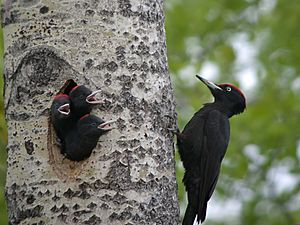
All woodpeckers make their nests in holes. They almost always dig these holes in the trunks and branches of trees, away from the leaves. They try to find a spot with rotten wood surrounded by strong wood. If there aren't many trees, the gilded flicker and ladder-backed woodpecker dig holes in cactus plants. The Andean flicker and ground woodpecker dig holes in earth banks.
The campo flicker sometimes chooses termite mounds. The rufous woodpecker prefers to use ants' nests in trees, and the bamboo woodpecker specializes in bamboos. Woodpeckers also dig nest holes in buildings, wooden poles, and other structures made by people.
Both the male and female woodpecker work together to build the nest, incubate the eggs, and raise their young. In most species, the male does most of the digging for the nest and sits on the eggs at night. A group of eggs, called a clutch, usually has two to five round, white eggs. Because these birds nest in holes, their eggs don't need to be camouflaged. The white color helps the parents see them in the dim light inside the nest.
The eggs hatch after about 11–14 days. Then, it takes about 18–30 days for the baby birds to grow their feathers and be ready to leave the nest. In most species, the young birds are left to take care of themselves soon after they fledge. Nesting in cavities is a good strategy, and more young birds survive this way compared to birds that nest in the open. In Africa, some species of honeyguide birds lay their eggs in woodpecker nests, making the woodpeckers raise their young.
Woodpeckers and People
Most people like woodpeckers. They are seen as interesting birds and are fun to watch as they drum or look for food. However, not everyone appreciates what they do. Many woodpecker species are known to dig holes in buildings, fences, and utility poles. It can be very hard to stop them, and fixing the damage can be expensive.
Woodpeckers sometimes cause problems when they eat fruit crops. But their search for food is mostly helpful. They control insect pests in forests, like woodboring beetles, which dig tunnels under bark and can kill trees. They also eat ants, which sometimes protect sap-sucking pests like mealybugs. This is helpful in places like coffee farms in India, where rufous woodpeckers eat these pests.
Woodpeckers can also be "indicator species." This means their presence shows how healthy a habitat is. Their ability to make holes is important for the ecosystem. These holes are used by many other bird species that can't dig their own nests. Various mammals and insects also use these cavities.
Woodpeckers in Stories and Games
One old story about the founding of Rome says that a woodpecker brought food to the boys Romulus and Remus when they were left alone in the wild. This helped them survive and become important in history.
The Pokémon Pikipek, from the games Pokémon Sun and Moon, looks like a pileated woodpecker. The game's encyclopedia says this small flying Pokémon acts like a real woodpecker. Its later forms, Trumbeak and Toucannon, look like a honeyguide and toucan. This is a fun nod to how woodpeckers are related to these other bird families.
Saving Woodpeckers
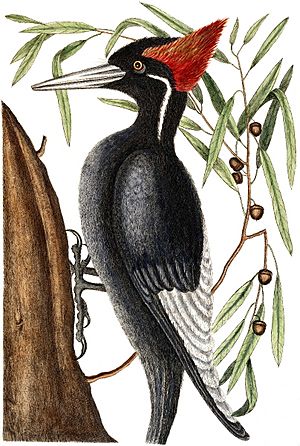
Several woodpecker species are in danger because their homes are being destroyed. Since they are woodland birds, cutting down forests for farms or other uses can greatly reduce their numbers. Some species can adapt to living in tree farms or open areas with a few trees, but others cannot. A few species have even done well by adapting to places made by humans.
There are not many conservation projects just for woodpeckers. But they benefit whenever their habitat is protected. A lot of effort has been put into saving the red-cockaded woodpecker in the southeastern United States. People have built artificial holes in the longleaf pines that these woodpeckers like for nesting.
Two woodpecker species in the Americas are in serious trouble. The ivory-billed woodpecker is critically endangered, and the imperial woodpecker is thought to be extinct in the wild. Some experts believe they are already gone, though there have been possible but unconfirmed sightings of ivory-billed woodpeckers in the United States, and a small group might still live in Cuba. Another critically endangered species is the Okinawa woodpecker from Japan. There are only a few hundred of these birds left, and their numbers are shrinking. They are threatened by deforestation, building golf courses, dams, helipads, roads, and farms.
Woodpeckers Inspire New Inventions
The spongy bones in a woodpecker's skull and its flexible beak protect its brain when it drums. These features have given engineers ideas for new designs:
- A black box needs to stay safe when a plane crashes. By designing black boxes like a woodpecker's skull, engineers have made them 60 times more resistant to damage.
- The design of protective helmets is another area where studying woodpeckers has helped.
- Special honeycomb beams, inspired by the woodpecker's skull, are being designed to handle many impacts without needing to be replaced.
Interesting Facts About Woodpeckers
- You can find woodpeckers all over the world, except in Australia, New Guinea, New Zealand, Madagascar, and the very cold polar regions.
- Most species live in forests or woodlands. However, a few species live in treeless areas like rocky hillsides and deserts.
- The Gila woodpecker is special because it lives in and uses cacti.
- The Picidae family includes about 240 different species of birds, grouped into 35 genera.
- Almost 20 species are in danger of extinction because their homes are being lost or broken up. One species, the Bermuda flicker, is already extinct, and two others might be.
- Male and female woodpeckers often look a little different from each other, but these differences are usually small.
- They have long, sticky tongues that help them pull out food like insects and larvae.
- Many of the ways woodpeckers find food, breed, and communicate involve drumming and hammering with their beaks.
- Pecking makes a woodpecker's skull heat up. This is one reason why they often peck in short bursts with quick breaks, giving their head time to cool down.
See also
 In Spanish: Pájaro Carpintero para niños
In Spanish: Pájaro Carpintero para niños


